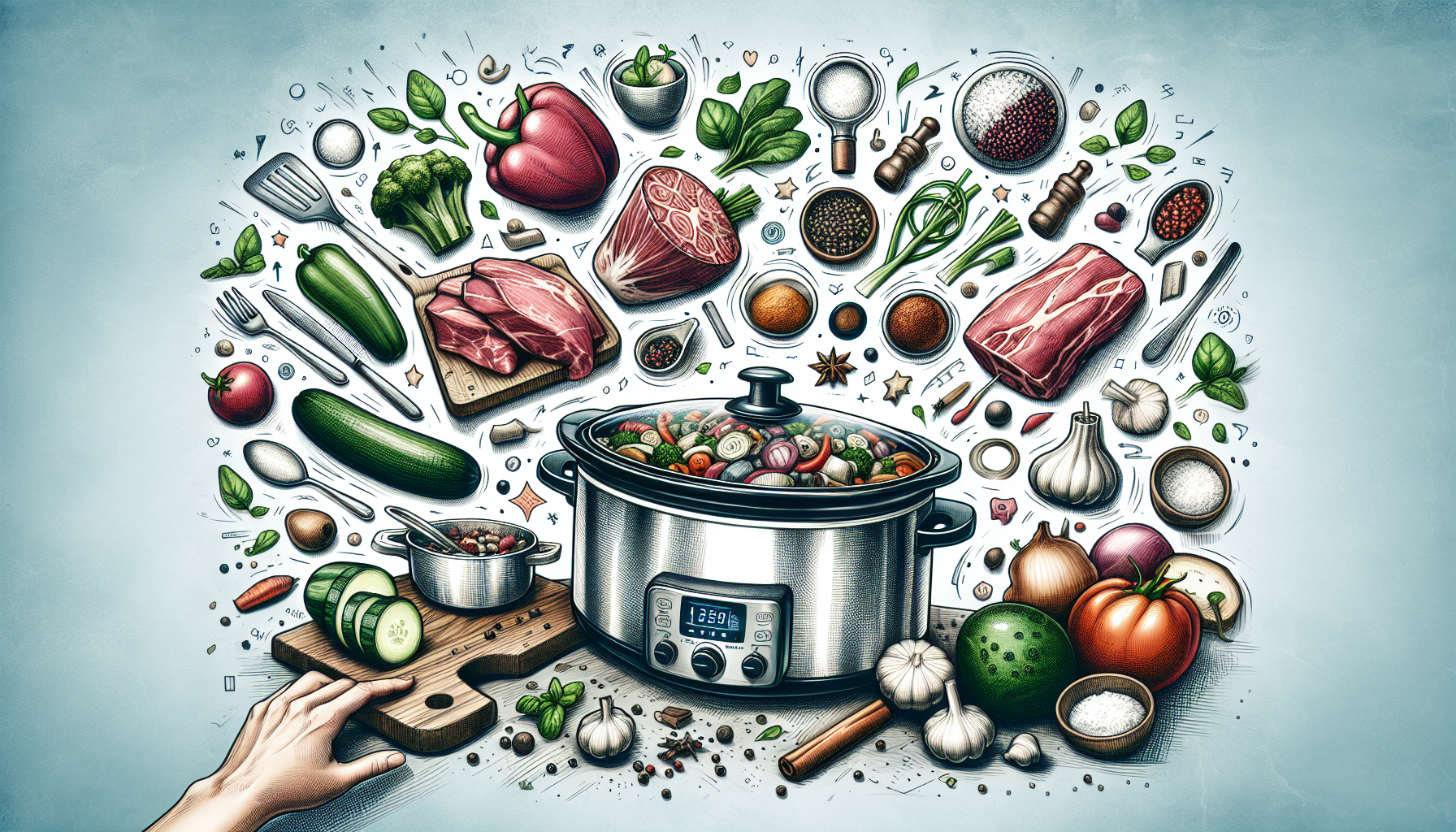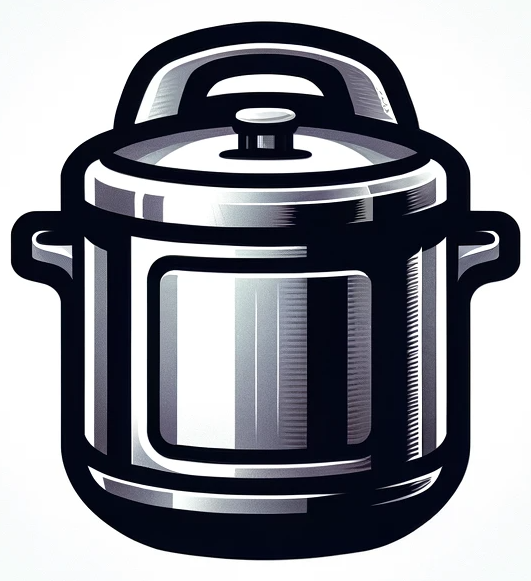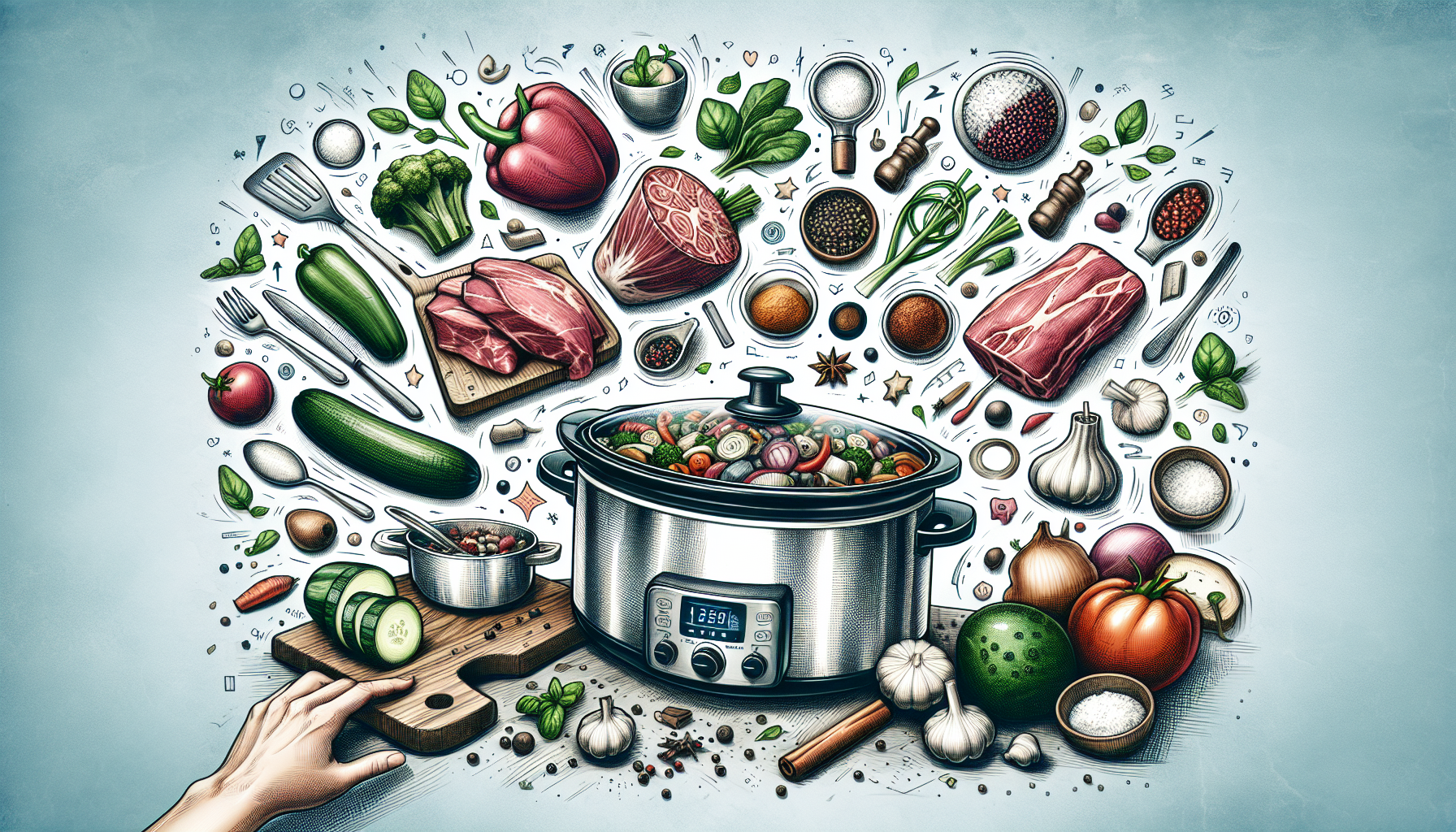If you’ve ever wondered about the wonders of a slow cooker, look no further. This article will unravel the mystery behind this kitchen appliance and unveil its versatility in transforming ordinary ingredients into mouthwatering dishes with minimal effort. From hearty stews to tender roasts and even delectable desserts, a slow cooker has become a beloved companion for home cooks seeking flavorful meals that practically cook themselves. Curious to learn more? Let’s dive into the world of slow cooking and discover the endless possibilities it offers.

CHECK OUT PRESSURE COOKERS ON AMAZON
What Is a Slow Cooker?
Definition
A slow cooker, also known as a crock-pot, is a kitchen appliance used for slow cooking food at a low temperature over an extended period. It consists of a removable pot, often made of ceramic or porcelain, and a heating element which is enclosed within the base. The pot is placed on the heating element, and the heat radiates evenly, ensuring that the food is cooked slowly and evenly.
Features
Slow cookers typically have a low and high heat setting, allowing you to adjust the temperature based on the recipe or the desired cooking time. Many models also have a “keep warm” setting, enabling you to maintain the serving temperature of your cooked food without overcooking it. Most slow cookers come with a removable lid that helps retain moisture and flavor while allowing you to easily monitor the cooking process.
Types
There are various types of slow cookers available in the market, catering to different cooking needs and preferences. The most common types include manual slow cookers, programmable slow cookers, and multi-cookers. Manual slow cookers offer basic temperature settings and require manual monitoring and adjustment by the user. Programmable slow cookers allow you to set cooking times and temperatures in advance, providing more convenience and flexibility. Multi-cookers, such as the popular Instant Pot, combine the functions of a slow cooker with other cooking methods like pressure cooking and sautéing, offering a versatile cooking appliance.
Advantages of Using a Slow Cooker
Saves Time and Effort
Using a slow cooker can save you a significant amount of time and effort in the kitchen. Once you have added the ingredients to the pot and set the temperature and cooking time, you can leave the slow cooker unattended while it works its magic. This frees up your time to focus on other tasks or simply relax, knowing that your meal will be ready when you are.
Enhances Flavor
One of the greatest advantages of slow cooking is that it intensifies the flavors of your dishes. The long, slow cooking process allows the flavors of the ingredients to meld together, resulting in rich and deeply satisfying meals. The low and slow cooking also helps to develop complex flavors that are difficult to achieve through other cooking methods.
Tenderizes Tough Meat
Slow cooking is particularly useful for cuts of meat that are usually tougher and less tender. The low temperature and extended cooking time break down the connective tissues, resulting in tender and juicy meat. This makes slow cookers ideal for preparing dishes such as pot roasts, stews, and pulled pork, where you want the meat to be fork-tender.
Retains Nutrients
Contrary to popular belief, slow cooking can actually help retain nutrients in the food. The gentle and prolonged cooking process reduces the loss of water-soluble vitamins and minerals, preserving their nutritional value. Additionally, the slow cooker’s sealed lid helps prevent the evaporation of moisture, ensuring that the food retains its natural juices and flavors.
Reduces Energy Consumption
Slow cookers are energy-efficient appliances compared to conventional ovens or stovetop cooking. The long cooking time at a low temperature consumes less energy overall, making it an environmentally friendly and cost-effective cooking method. Slow cookers also generate less heat in the kitchen, especially useful during hot summer months when using the oven can be uncomfortable.
Popular Slow Cooker Recipes
Pot Roast
A classic slow cooker recipe, pot roast involves cooking a tough beef cut, such as chuck roast, with vegetables and flavorful seasonings. The long, slow cooking time allows the flavors to meld together, resulting in supremely tender meat and deliciously hearty vegetables.
Chili
Chili is another favorite dish that can easily be prepared in a slow cooker. Simply brown your ground meat and sauté your onions and peppers, then combine them with tomatoes, spices, and beans in the slow cooker. Allow it to cook low and slow for several hours, and you’ll be rewarded with a rich and flavorful chili.
Pulled Pork
Pulled pork is a Southern specialty that is perfectly suited for slow cooking. Season a pork shoulder with your favorite spices, place it in the slow cooker, and let it cook on low for several hours until the meat is falling apart tender. Shred the pork and mix it with your preferred barbecue sauce for a crowd-pleasing pulled pork sandwich or taco filling.
Stews and Soups
Slow cookers are excellent for preparing hearty stews and soups. Whether it’s a classic beef stew, a comforting chicken noodle soup, or a flavorful vegetarian chili, the slow cooker allows the flavors to develop and intensify over time. Add your ingredients in the morning and come home to a comforting and delicious meal.
Desserts
Yes, slow cookers can even be used to make desserts! From warm and gooey bread puddings to rich chocolate lava cakes, there are countless dessert recipes that can be prepared in a slow cooker. The gentle heat ensures a moist and tender outcome, perfect for indulging in a sweet treat.
Tips for Using a Slow Cooker
Choose the Right Size
When purchasing a slow cooker, consider the size that best suits your needs. Slow cookers come in a range of sizes, from small, two-quart models to large, eight-quart models. Choose a size that can accommodate the portion sizes you typically cook and the number of people you usually serve.
Layer Ingredients Properly
To ensure even cooking and prevent mushy textures, it’s important to layer the ingredients in the slow cooker properly. Place root vegetables and dense ingredients at the bottom, where they will be closer to the heat source. Add meats on top of the vegetables, followed by any spices, seasonings, and liquids.
Prep Ingredients in Advance
To save time in the morning or when you’re busy, consider prepping your ingredients the night before and refrigerating them in separate containers. This way, you can simply transfer everything into the slow cooker in the morning, minimizing the prep work and maximizing convenience.
Use the Correct Cooking Time and Temperature
Follow the recipe instructions and guidelines for cooking time and temperature settings. Each recipe may have specific requirements to ensure proper cooking and optimal flavors. If you’re adapting a traditional recipe for the slow cooker, be sure to adjust the cooking time and temperature accordingly.
Add Dairy and Delicate Ingredients Later
If a recipe includes dairy products or delicate ingredients like fresh herbs or seafood, it’s best to add them towards the end of the cooking time. Dairy products can curdle or separate when subjected to long cooking times, while delicate ingredients can become overcooked or lose their vibrant flavors.
Avoid Lifting the Lid Frequently
Resist the temptation to lift the lid and check on your dish too often. Each time you open the slow cooker, heat escapes, prolonging the cooking time and compromising the flavors. If you must check on your food, try to limit it to about once or twice during the cooking process.
Experiment with Flavors
One of the joys of slow cooking is the opportunity to experiment with flavors. Don’t be afraid to get creative and try new combinations of spices, herbs, and seasonings. The long cooking time allows the flavors to blend together, often resulting in delicious surprises.
Ensure Food Safety
It’s crucial to prioritize food safety when using a slow cooker. Always thaw frozen ingredients thoroughly before adding them to the slow cooker, as the low cooking temperature may not be sufficient to safely thaw the food. Additionally, ensure that the internal temperature of meats reaches the appropriate level to prevent the growth of harmful bacteria.
Cleaning and Maintaining a Slow Cooker
Cleaning the Removable Parts
Most slow cookers have removable ceramic or porcelain pots that are easy to clean. After cooking, let the pot cool down, and then wash it with warm, soapy water. If there are stubborn food particles, allow the pot to soak for a while before washing. The removable lid should also be washed using warm, soapy water.
Cleaning the Base and Exterior
Make sure the base and exterior of the slow cooker are unplugged and cool before cleaning. Wipe the exterior with a damp cloth and mild detergent, ensuring that no liquids seep into the electrical components. Use a dry cloth to remove any moisture and prevent damage to the appliance.
Proper Storage
When not in use, it’s important to store the slow cooker properly. Ensure that the removable pot and lid are completely dry before placing them back in the slow cooker. If possible, store the slow cooker in a cool and dry place, away from direct sunlight and heat sources.
Preventing Common Issues
To prevent common issues with slow cookers, such as food sticking to the pot or uneven cooking, it’s helpful to follow a few guidelines. Consider using cooking liners or non-stick cooking spray to prevent food from sticking. If your slow cooker tends to cook faster or slower than desired, adjust the cooking time or temperature accordingly.
Replacing Parts When Needed
Over time, certain parts of the slow cooker may need to be replaced. This includes cracked or damaged pots, chipped lids, or malfunctioning temperature controls. Check with the manufacturer or retailer for replacement parts, ensuring that you purchase the correct parts for your specific model.
Alternative Uses for a Slow Cooker
Making Mulled Beverages
Slow cookers are excellent for making warm and flavorful beverages, particularly during the colder months. Whether it’s mulled cider, spiced wine, or hot chocolate, simply combine the ingredients in the slow cooker and let them infuse slowly for a delightful and comforting drink.
Baking Bread
Yes, you can bake bread in a slow cooker! Slow cooker bread is becoming increasingly popular as it allows for a moist and tender loaf with a crusty exterior. There are numerous slow cooker bread recipes available, from simple white bread to more adventurous flavors like rosemary and olive oil.
Keeping Food Warm for Parties
When hosting parties or gatherings, a slow cooker can be a useful tool for keeping food warm throughout the event. Whether it’s meatballs in marinara sauce, a cheesy dip, or a hot and spicy chili, the slow cooker’s “keep warm” setting ensures that your guests can enjoy your delicious creations at their own pace.
Cooking Oatmeal Overnight
Waking up to a warm and comforting bowl of oatmeal in the morning is a breeze with a slow cooker. Simply combine oats, liquid, and your desired flavorings, then set the slow cooker on low before going to bed. You’ll wake up to perfectly cooked oatmeal, ready to be topped with your favorite fruits and nuts.
Melting Chocolate or Butter
Melting chocolate or butter can be a delicate process, but the slow and even heat of a slow cooker makes it a breeze. Whether you’re preparing chocolate for dipping fruits or melting butter for a recipe, place the ingredients in a heatproof container, and set it in the slow cooker filled with hot water. Allow the ingredients to slowly melt, stirring occasionally until smooth.
Infusing Oils and Extracts
Slow cookers can be used to infuse oils and extracts with a variety of flavors. Whether you’re infusing olive oil with herbs like rosemary and garlic or creating homemade vanilla extract with beans and alcohol, the low and consistent heat of the slow cooker ensures that the flavors are fully extracted and infused into the liquids.
Slow Cooker vs. Instant Pot
Comparison of Features
While slow cookers and Instant Pots both offer convenient ways to prepare meals, there are key differences in their features. Slow cookers focus solely on slow cooking at low temperatures, while Instant Pots combine multiple cooking methods such as pressure cooking, sautéing, and slow cooking in one appliance. Instant Pots also tend to have more versatile features, including pre-programmed settings and adjustable pressure levels.
Different Cooking Techniques
The primary difference between slow cookers and Instant Pots lies in their cooking techniques. Slow cookers cook food slowly over a long period, while Instant Pots use pressure to cook food quickly. Slow cookers are ideal for recipes that benefit from long, slow cooking processes, while Instant Pots are perfect for those who need to prepare meals quickly or want to incorporate various cooking methods into their cooking routine.
Ease of Use and Convenience
When it comes to ease of use, slow cookers are often considered simpler and more straightforward. They typically have fewer features and are easy to operate with basic temperature settings. However, Instant Pots come with pre-programmed settings and offer a wider range of functions, making them more versatile but also potentially more complex for new users.
Ideal Recipes for Each Appliance
The ideal recipes for slow cookers are those that require longer cooking times, such as stews, roasts, and soups. These dishes benefit from the gentle heat and allow the flavors to develop over time. On the other hand, Instant Pots are excellent for recipes that require quick cooking, such as soups, curries, rice dishes, and even desserts. They are particularly beneficial for individuals with busy schedules and limited time to spend in the kitchen.
Slow Cooker Safety Guidelines
Ensuring Electrical Safety
When using a slow cooker, it’s essential to prioritize electrical safety. Ensure that the power cord and plug are in good condition, without any frayed wires or exposed areas. Avoid using extension cords, as they may not provide a stable power supply. Always plug the slow cooker into a properly grounded outlet to minimize the risk of electrical accidents.
Avoiding Potentially Hazardous Ingredients
While slow cookers are generally safe to use, certain ingredients can pose risks if not handled correctly. Avoid adding frozen ingredients directly to the slow cooker, as they can take longer to reach safe cooking temperatures. It is also advisable to avoid cooking dishes with high-risk ingredients like raw eggs or seafood for extended periods in a slow cooker.
Proper Handling of Raw Meats
When preparing dishes with raw meats in a slow cooker, it’s crucial to handle them properly to prevent foodborne illnesses. Thoroughly wash your hands and utensils before and after handling raw meats. Ensure that raw meats are cooked to the appropriate temperature to kill any harmful bacteria. Use a food thermometer to check the internal temperature and follow the recommended guidelines for each type of meat.
Avoiding Overfilling
It’s important not to overfill the slow cooker to prevent potential issues. Overfilling can lead to uneven cooking, longer cooking times, or even spillage. As a general rule, fill the slow cooker no more than two-thirds full to allow enough space for the ingredients to expand during cooking.
Monitoring Cooking Progress
Although the beauty of a slow cooker is the ability to leave it unattended, it’s still important to periodically monitor the cooking progress. This is particularly important when cooking new recipes or adjusting cooking times and temperatures. If you notice any issues, such as burning smells or excessive bubbling, it may indicate a problem with the slow cooker or the recipe, and it should be addressed promptly.
CHECK OUT PRESSURE COOKERS ON AMAZON
Slow Cooker Accessories
Airtight Lids and Covers
Airtight lids and covers are essential accessories for slow cookers. They help retain moisture and heat, allowing for more even and efficient cooking. Some slow cookers come with locking lids, which are particularly useful for transporting your dishes or preventing any accidental spills.
Temperature Probes
Temperature probes are useful tools for measuring the internal temperature of your food, ensuring that it reaches the safe cooking temperature. They are particularly handy when cooking meats or poultry, where achieving the correct temperature is crucial for food safety.
Carrying Bags
If you often bring your slow cooker to potlucks, parties, or family gatherings, a carrying bag can be a valuable accessory. These bags provide protection, make transportation easier, and can even come with additional compartments for storing utensils or condiments.
Cooking Liners
Cooking liners, often made of heat-resistant materials, can be placed inside the slow cooker pot to prevent food from sticking and make cleaning up quick and easy. They eliminate the need for scrubbing and soaking, saving you time in the kitchen.
Cookbooks and Recipe Collections
Expand your slow cooking repertoire with cookbooks and recipe collections specifically designed for slow cookers. These resources offer a wide range of recipes, tips, and techniques to help you make the most of your slow cooking experience. Whether you prefer comfort food classics or exotic international dishes, there is a slow cooker cookbook to suit your tastes.
Conclusion
In conclusion, a slow cooker is a versatile and convenient kitchen appliance that offers a wide range of benefits. From saving time and effort to enhancing flavors and tenderizing tough meats, it is a valuable addition to any kitchen. With popular recipes ranging from pot roasts and chilies to desserts and bread, the slow cooker allows for endless possibilities in cooking. By following proper tips for usage, cleaning, and safety, you can enjoy the convenience and delicious results that a slow cooker offers. So go ahead, dust off your slow cooker or consider investing in one, and embark on a culinary journey filled with flavorful and comforting meals.

